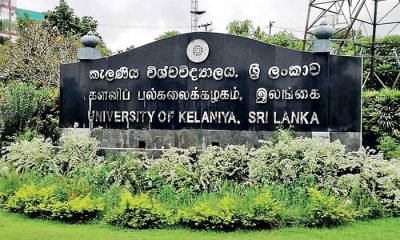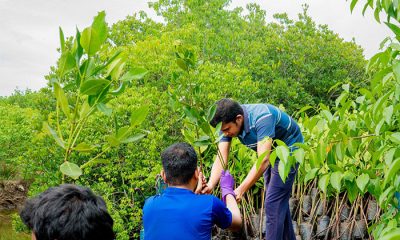Features
Establishing a self-financing Disability Studies Unit a the University of Kelaniya

(Excerpted from Memories that Linger: My journey through the world of disability by Padmani Mendis)
We had entered the last decade of the millennium. And I had aged into my sixties. I was thoroughly involved in my work, travelling extensively. Often, I would be away for eight or nine months of the year; never continuously, always coming home in between assignments. And I was tired. Long standing diabetes and knees degenerating from Osteoarthrosis were taking their toll.
So I said to my Swedish friends that I would like to have others take over and now stay at home. Kristina would have none of it. “But you can’t stop teaching,” she said, “I understand what you say. Instead of you having to travel about, we will bring students to you.” This was the first of three remarkable incidents.
At about the same time, Einar’s replacement at WHO had discussed with me the need to institutionalise Community Based Rehabilitatuin (CBR) in academia. He asked me to look for a suitable university on my travels that will be willing to initiate CBR education. This was the second incident.
The third is when, not too long after this, I received a message from the Vice Chancellor of the University of Kelaniya in Sri Lanka, Professor M.M.J. Marasinghe, saying he would like to meet me. When we did so, he said that he would like to introduce disability as an area of interest to this university. Could I help him? Oh, could I!
A series of three coincidences. Destiny again?
I shared with the Vice Chancellor my work in CBR and my relationships with Radda Barnen, with WHO and with Uppsala University and their current thinking about the need for recognised education.
Prof. Marasinghe’s request was opportune. We could do something for sure. He brought in other faculty members for discussions. Prof. K. Tillekeratne, then Dean of the Faculty of Science was most supportive of the whole initiative. They would like to establish an educational activity in the Faculty of Medicine which was set up newly in 1991. Prof. Carlo Fonseka had been appointed its first Dean. He was invited to the discussions and was agreeable to the suggestion. This was now early January1993.
An International Delegation in Sri Lanka
One month later, a delegation of five headed by Yngve was in Sri Lanka. Others in the team were Einar’s successor in Geneva, Enrico Pupulin, Kristina Fenno from Radda Barnen, Tom Lagerwall from the Swedish Handicap Institute with whom also I had worked, and Ingrid Cornell, representing the Swedish International Development Agency which may provide financial support if the initiative was suitable.
I had arranged a programme for them to first meet Prof. Fonseka and decide on the preliminaries. With Prof. Fonseka later that morning the group met Prof. Marasinghe. In the afternoon Prof. Fonseka led the group to a long meeting with Prof. Arjuna Aluwihare, who was the Chairman of the University Grants Commission, UGC. Prof. Aluwihare and Yngve got on famously, sharing much in common as experienced medical academicians.
By the end of that meeting, a preliminary Memorandum of Understanding or MOU had been reached between the UGC and the international team. This was put into a draft document to be discussed further by each side before they next met.
The core of the draft was that a Disability Studies Unit (DSU) would be established at the Faculty of Medicine, Kelaniya University. It would function directly under the Dean. Its purpose would be CBR education, research and publications both at an international level and in Sri Lanka.
As an initial activity the DSU would organise and carry out over the next two years, two international courses in CBR, each six weeks in length, each for 20 – 25 participants. Financial support would be provided by SIDA and Radda Barnen and channelled through the International Child Health Unit or ICH of Uppsala University.
Details about how this would be done were also in the draft. When asked, the Swedish delegation made one request of Prof. Aluwihare. It was that I be given responsibility for the DSU and for the two initial CBR courses. Prof. Aluwihare looked at me and we smiled.
The same group met Prof. Aluwihare the next morning with further suggestions. The draft was finalised, made ready and signed by him and Yngve.
Late that afternoon, Yngve took a flight back to Sweden. All done and dusted within two days. The other team members stayed on until Friday, meeting relevant people for discussions. More information gathering really. Included was a field visit to a CBR project. We used this project later as one of the field study areas for the international course participants.
The Disability Studies Unit is Born
And so, the DSU came into being. Prof. Fonseka asked me to come in on an informal basis to get the DSU started until I was given a formal appointment. Prof. Fonseka was Professor of Physiology and I met him in his office. On this my first day he said to me, “Padmani, it will be easiest all round if I gave you space in this department.”
He took me to a large, spacious, airy room and said, “You can have this for the DSU.” It had a desk and a chair. I was happy with that. The post of “Course Director” was soon formally advertised and three applicants were interviewed. I took up my appointment on April 26, 1993.
There were two remarkable clauses in the Memorandum of Understanding. The first was that ICH (International Child Care Unit of the Unversity of Uppsala) would meet the cost of setting up the DSU. This included all the equipment we would need. Also, the salaries of three staff for the rest of the year, at the end of which Kelaniya University was expected to take over that cost.
It was this allocation that the Faculty used to employ for us Kodi and Senevi, two of my former physiotherapy colleagues. The three of us worked together to get the course going. They then participated in the first course to learn more about CBR. They became teachers on the local courses we organised.
Before he left, Yngve had asked me to make a list of the equipment that the Disability Studies Unit, DSU, would require and fax it to him as soon as possible. He said particularly, “Don’t forget to include a vehicle for your use.”
The second remarkable clause was that the two CBR courses were arranged on a “sell-buy” basis. The DSU sold each course wholesale to ICH to buy using funds provided by SIDA and Radda Barnen. This was Yngve’s innovation, with Prof. Aluwihare’s unhesitating concurrence. The DSU arranged the residential course programme, invited and hosted resource persons, estimated the cost of the course per participant and forwarded it to the ICH at Uppsala University.
ICH selected 20 – 25 international participants and forwarded to us information about them. We made arrangements for each participant’s return travel and made sure their itinerary and travel tickets reached them in time. Each was met at the airport and brought to the course venue and residence, the Mount Royal Beach Hotel, Mount Lavinia, then under Sri Lankan ownership.
ICH paid us for all these. On the first course the participants came from 12 countries. On the second, from 14 countries. The cooperation of Thomas Cook, Colombo was memorable indeed. There were no travel hitches for any single participant. That was their achievement.
The First International Course on Community-Based Rehabilitation
Yngve attended the first course to launch the cooperation and the course. In his honour, we asked the hotel to have all the flowers in blue (manel) and yellow (araliya) flowers. The hotel was amazed, remarking that these flowers are not expensive. To us it was not the cost, but the colours and the beauty of the flowers that was important. Blue and yellow are the colours of Sweden. The hotel had gone to town and placed them all over. Making the room quite festive and beautiful. We had large flags of both countries on each side of the top table.
We arranged travel and accommodation for our international resource persons in the same way. We invited Einar to both courses. He came willingly to share both his experience and his happiness about the whole thing. Other resource persons were “Baby” Estrella from the Philippines to share her experience of disability as a wheelchair user and Joy Valdez to share hers as a CBR pioneer in the same country.
For the second course and thereafter, we invited Joy as well as Javed Abidi from New Delhi to share his experience of disability and as that of a successful activist. We also had other international resource persons for specific modules. And eminent Sri Lankans for special topics.
Sri Lankan disabled people were always invited as resource persons as soon as we could, no later than the second day. There were a few participants who had never had prior exposure to disabled people. This was not surprising – those were the times.
The First Self-Financing Unit
There was a very significant and carefully planned outcome of this sell-buy agreement. Planned by Yngve. When the DSU costed each course, we could add a percentage of the total as the cost of organising it and of running it. This was profit that we maintained in our own bank account. The Faculty though, was responsible for it and only its staff could sign cheques. We could only see the monthly statements. We followed the same practice with all the local courses that we did.
Uppsala paid us in USD. For this, we were given permission by the Central Bank to maintain a USD account at the People’s Bank NRFC branch. An exceptional approval at that time. So the DSU (Disability Studies Unit) was wealthy! But we didn’t just accumulate this wealth. We used some of our profits to run our unit. We paid our own salaries, met the costs of running our own vehicle and hiring our own driver, and of all the material we needed for the unit. All fair and square and we donated a share to the Faculty. And we invested any to spare in fixed deposits so as to add to our capital.
The DSU was a profit-making venture. It was financially independent. And it was the first self-financing unit in our university system.
The DSU was the only section in the faculty that had its own vehicle. The Dean would ask for it whenever his was not available. Other faculty members felt free to do the same. Those were the early days of computers, and we had three; we had our fax machine, own phone line, photocopier, a library and absolutely all the equipment required to run the Unit. So it was no surprise that many faculty members were often in and out of our room. It was not long therefore that the DSU became “a part” of the faculty.
When that Memorandum of Understanding ended Yngve had retired and his replacement had taken over. He had not proved himself to SIDA so our MOU could not be extended. But the purpose of the MOU was achieved. DSU was now established in the faculty. It would grow.
And grow it did with increasing demands on our work. Made possible by Prof. Fonseka’s unstinting support. We ran two more similar international courses in the next three years. One was at the request of the two WHO Regional Offices for South East Asia and for the Western Pacific. The other we organised ourselves. I had still been doing international work and travelling. The DSU had good relationships with sponsors who had sent us participants over the three years. We advertised our course to these contacts. An adequate number purchased places on our course to enable us to run it independently.
By the time we completed just the four international activities, we had reached and prepared 89 participants from 27 countries to improve in one way or another, the situations and lives of countless disabled people in their own countries.
Features
Iain Douglas-Hamilton: Science, courage, and the battle for elephants
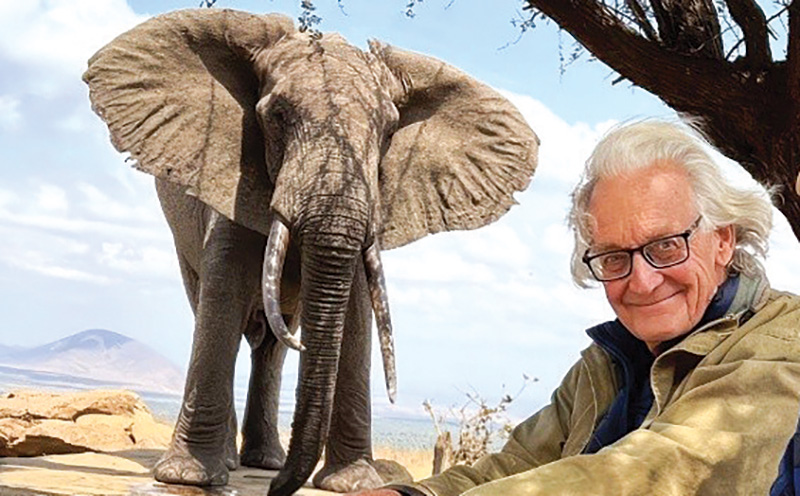
Passing of Iain Douglas-Hamilton, a man who dedicated his life to conservation and whose life’s work leaves a lasting impact on our appreciation for, and understanding of, elephants.
– Prince William
In Africa on 08 December, 2025, when the sun slipped below the horizon, it did not only give an end for that day, but it also marked the end of a man whose knowledge and courage saved Africa’s elephants. This gentleman was none other than Iain Douglas-Hamilton! There is a beautiful African proverb that says, “When an old man dies, a library burns to the ground,” and it resonates well with Iain’s demise.
Iain pioneered behaviour research on elephants, and he was the first to highlight the elephant poaching crisis in Africa. Also, the adventures he went through to save the elephants will inspire generations.
From Oxford to Africa

The Life of the Last Proboscideans: Elephants”, authored by Muthukumarana, stands as an awardwinning, comprehensive study that integrates elephant evolution, anthropology, biology, behaviour, and conservation science.
Iain was born on 16 August, 1942, into an aristocratic family, the son of Lord David Douglas-Hamilton and Ann Prunella Stack. His parents were a distinguished couple in Britain: his father, a Scottish nobleman, served as a squadron leader in the Royal Air Force, while his mother was a pioneering figure in physical fitness and a prominent advocate for women’s rights. After finishing his school, Iain was admitted to Oxford University to study zoology. At the age of 23, for his PhD, Iain travelled to Tanzania to study the behaviour of elephants at Lake Manyara National Park. This was a daring and humble beginning that would change how the world understood elephants. He learnt to recognise individual animals based on their tusks and ears. He observed their family bonds, their grief, and their intelligence. These findings made the scientific community identify elephants as sentimental beings. During this period, he married Oria Rocco, and together they had two children, Saba and Mara.
Battle for the elephants
When ivory poaching swept across Africa and devastated elephant populations, Iain did not withdraw in despair. He confronted the crisis head-on, guided by science, rigorous data, and unwavering resolve. Through extensive aerial counts and field studies, he laid bare the scale of the tragedy—revealing that Africa’s elephant numbers had collapsed from an estimated 1.3 million to just about 600,000 in little more than 10 years.
It was largely thanks to his work that the global community saw—perhaps for the first time—the full scope of the crisis. His efforts played a pivotal role in pushing forward the 1989 international ban on ivory trade, a landmark moment for wildlife conservation.
In 1993, Iain founded Save the Elephants (STE), an organisation that would become the heart of elephant conservation efforts in Kenya and across Africa.
At STE, he pioneered the use of GPS-tracking and aerial survey techniques to monitor elephant movements, protect them from poaching, and plan safe corridors for them in increasingly human-dominated landscapes. These methods have since become standard tools in wildlife conservation worldwide.
Beyond technology and science, Iain was a mentor. He inspired — and continues to inspire — generations of conservationists, researchers, and everyday people who care deeply about wildlife. Through his books (such as Among the Elephants and Battle for the Elephants), documentaries, lectures, and personal example, he invited the world to see elephants not as trophies or commodities, but as sentient beings — worthy of awe, study, and protection.
Iain and Sri Lanka
In 2003 Iain came to Sri Lanka for the first time to attend the “Symposium on Human-Elephant Relationships and Conflict” as the keynote speaker. On that day he concluded his address by saying, “When I hear the talk of Problem Animal Control, I always wonder whether our species has the capacity for its own self-regulation or Problem Human Control in a humane and wise manner. HEC stands for Human Elephant Conflict, one of our focuses of this conference. How I wish it could come to stand for Human Elephant Coexistence, based on a recognition that other beings also need their space to live in. We are a long way from that, but I am sure that many of the findings of the talented body of researchers in this room will begin a stepwise progress in answering some of these fundamental problems.”
A few years ago Iain’s organisation STE collaborated with the Sri Lankan Wildlife Conservation Society for research activities aimed at reducing human-elephant conflict. In 2016 when the Sri Lankan government was going to destroy the confiscated illegal African elephant ivory, I made a request for Iain to write a congratulatory message to Sri Lanka’s President and Prime Minister for the wise decision they had taken. Iain sent me a four-page meaningful letter written by him, and he was joined by 18 other conservation organisations. In his letter he mentioned, “I want to offer my congratulations to the government of Sri Lanka for the laudable decision to destroy ivory stocks…” Sri Lanka is sending a message to the world that ivory should be without worth; elephants have value when alive. This is a critical message to send, particularly to the religious world, as they are sensitised about the threat religious ivory poses to elephant populations in Africa.”
Fortunately, Iain’s conservation is taken up by his children, especially his eldest daughter, Saba. In 2016 and 2024 she came to Sri Lanka for a lecture hosted by the Galle Literary Festival. Also in 2019, for the Wildlife and Nature Protection Society’s 125th Anniversary, Saba and her husband visited a gala dinner that was held to fundraise for conservation projects.
A difficult path
Iain’s path was never easy. He endured personal peril many times: from hostile terrain and unpredictable wild animals to being shot at by poachers while conducting aerial patrols over war-torn national parks.
Yet despite the danger, despite setbacks — flooded camps, lost data, shifting political tides — his conviction never wavered. His was a life marked by resilience. He refused complacency. He refused to surrender. And through every hardship, he remembered why he began: to give elephants a future.
Iain was also a pilot, and as the old English saying goes, “Pilots don’t die; they simply fly higher.” In that spirit, I wish the same peaceful ascent for Iain. My heartfelt condolences are with Iain’s family.
by Tharindu Muthukumarana ✍️
tharinduele@gmail.com
(Author of the award-winning book “The Life of Last Proboscideans: Elephants”)
Features
Awesome power of gratitude
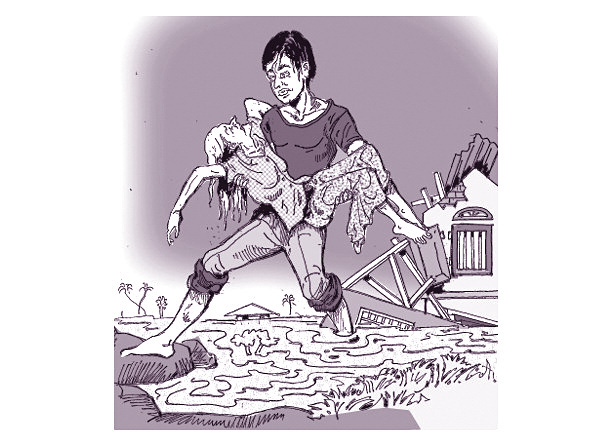
When you hear the word gratitude the first impression you get is a tail-wagging dog. If you feed a dog one day, it will wag its tail even if you meet it after a few years. That is gratitude. In addition, dogs are great teachers. They are at home in the world. They live in the moment and they force us to stay with them. Dogs love us and remain grateful unconditionally not for our bodies or bank accounts.
Small children are taught to say ‘Thank you’ for any favour they receive from others. They do not know that the two words can have positive effects on your health and the well-being of others.
Some time ago I had to call emergency services as I found one of my family members was unconscious. Within minutes an ambulance arrived and the paramedics whisked the patient away to the nearest hospital. He was in intensive care for a few days and returned home. We were marvelled at the impact of a handful of strangers who took charge of the patient at a critical time. I immediately wrote thank you notes to those who saved the patient’s life. I knew that it was a small gesture on my part. However, it was the only way I could express my gratitude to a dedicated team.
Selfless people
Later I realized that there are a large number of selfless people who do life-saving work, but they never expect anything in return. How volunteers saved a large number of flood victims is a case in point. The flood victims may not have expressed their gratitude in so many words. However, they would have felt a deep sense of gratitude to the volunteers who saved them.
Why do people come forward to help those facing natural disasters and other dangerous situations? A recent research in the United States shows that sharing thoughts of gratitude and performing acts of kindness can boost your mood and have other positive effects on your health. Almost all religions teach that gratitude does have a good impact on your happiness. Professor of Psychology Willibald Ruch says that gratitude is among the top five predictors of happiness.
By showing gratitude you can make positive changes in your own life. If you feel a sense of gratitude whenever you receive something that is good for you, it will be a healthy sign. You cannot get such a feeling in a vacuum because others have to play their roles. They can be your loved ones, friends, strangers or even people in authority. Gratitude is how you relate to them when you see yourself in connection with things larger than yourself.
Gratification lifestyle
Strangely, many people do not pause to appreciate what others are doing for them. For this you have to blame your gratification lifestyle. With the popularity of social media the young people feel that they are the centre of the universe. They seem to think there is no necessity to thank those who help them.
Why should we thank others even for minor favours? Recent studies show that those who express gratitude increase their own happiness levels. They also lower their blood pressure levels to a great extent. On the other hand, they will be able to sleep well and improve their relationships. They are also less affected by pain because of the positive impact on their depression.
They may not know that positive effects of gratitude are long lasting. Research shows that those who write thank you notes improve their mental health. There was also a decrease in their bodily pains. What is more, they feel more energetic in completing their daily activities. Unfortunately, schools and universities do not teach the value of gratitude since it is fairly a new field of study. Researchers are still trying to find out its cause and effect relationship. We know that those who perform acts of gratitude can sleep well. However, we do not know the reason for it. Researchers are wondering whether gratitude leads to better sleep or sleep leads to more gratitude. They also probe whether there is another variable that leads to gratitude and improved sleep.
Children
Despite such controversies, we know for certain that gratitude can benefit people at any stage of life. Most elderly people remain grateful for their children and grandchildren who support them. Elderly people cannot regain their physical strength or mental agility. Therefore they focus on gratitude. They are thankful to their children and grandchildren for their present situation.
How do gratitude recipients react? Research shows that those who receive thank you notes or acts of kindness experience positive emotions. You feel happy when someone holds a door open for you. Similarly, you are happy if you receive some unexpected help. Recently I was pleasantly surprised to see that someone has credited a big sum of money to my bank account in appreciation of a small favour I had done.
When you thank someone they are more likely to return the favour or pay kindness forward. Psychologically, people feel very happy when you thank them. However, some people hesitate to say thank you. The give-and-take of gratitude deepens relationships. In a close relationship husbands and wives do not thank each other. However, there are other ways of showing gratitude. A wife can make her husband feel appreciated. Such a feeling of appreciation will go a long way to strengthen their relationship.
Some people are ungrateful by nature. However, they can learn the art of being grateful. Such people will do well to maintain a gratitude journal. It is something similar to Pinpotha maintained by Buddhists in the past. They can record positive events in the journal. At the beginning this may not be easy. With practice, however, you can do it well. I knew of a man who kept a gratitude journal. Although his family members laughed at him, he did not give up the habit. When he was diagnosed with a terminal disease he used to read his gratitude journal very happily.
By R.S. Karunaratne ✍️
Features
Another Christmas, Another Disaster, Another Recovery Mountain to Climb

The 2004 Asian Tsunami erupted the day after Christmas. Like the Boxing Day Test Match in Brisbane, it was a boxing day bolt for Indonesia, Thailand, Sri Lanka, India and Maldives. Twenty one years later, in 2025, multiple Asian cyclones hit almost all the old victims and added a few more, including Malayasia, Vietnam and Cambodia. Indonesia and Sri Lanka were hit hard both times. Unlike the 2004 Tsunami, the 2025 cyclones made landfalls weeks before Christmas, during the Christian Season of Advent, the four-week period before Christmas preparing for the arrival of the Messiah. An ominously adventus manifestation of the nature’s fury.
Yet it was not the “day of wrath and doom impending … heaven and earth in ashes ending” – heavenly punishment for government lying, as an opposition politician ignorantly asserted. By that token, the gods must have opted to punish half a dozen other Asian countries for the NPP government’s lying in Sri Lanka. Or all those governments have been caught lying. Everyone is caught and punished for lying, except the world’s Commander in Chief for lying – Donald J. Trump. But as of late and none too sooner, President Trump is getting his punishment in spades. Who would have thought?
In fairness, even the Catholic Church has banished its old hymn of wrath (Dies irae, dies illa) that used to be sung at funerals from its current Missals; and it has on offer, many other hymns of peace and joy, especially befitting the Christmas season. Although this year’s Christmas comes after weeks of havoc caused by cyclonic storms and torrential rains, the spirit of the season, both in its religious and secular senses, will hopefully provide some solace for those still suffering and some optimism to everyone who is trying to uplift the country from its overflowing waterways and sliding slopes.
As the scale of devastation goes, no natural disaster likely will surpass the human fatalities that the 2004 Tsunami caused. But the spread and scale of this year’s cyclone destruction, especially the destruction of the island’s land-forms and its infrastructure assets, are, in my view, quite unprecedented. The scale of the disaster would finally seem to have sunk into the nation’s political skulls after a few weeks of cacophonic howlers – asking who knew and did what and when. The quest for instant solutions and the insistence that the government should somehow find them immediately are no longer as vehement and voluble as they were when they first emerged.
NBRO and Landslides
But there is understandable frustration and even fear all around, including among government ministers. To wit, the reported frustration of Agriculture Minister K.D. Lalkantha at the alleged inability of the National Building Research Organization (NBRO) to provide more specific directions in landslide warnings instead of issuing blanket ‘Level 3 Red Alerts’ covering whole administrative divisions in the Central Province, especially in the Kandy District. “We can’t relocate all 20 divisional secretariats” in the Kandy District, the Minister told the media a few weeks ago. His frustration is understandable, but expecting NBRO to provide political leaders with precise locations and certainty of landslides or no landslides is a tall ask and the task is fraught with many challenges.
In fairness to NBRO and its Engineers, their competence and their responses to the current calamity have been very impressive. It is not the fault of the NBRO that local disasters could not be prevented, and people could not be warned sufficiently in advance to evacuate and avoid being at the epicentre of landslides. The intensity of landslides this year is really a function of the intensity and persistence of rainfall this season, for the occurrence of landslides in Sri Lanka is very directly co-related to the amount of rainfall. The rainfall during this disaster season has been simply relentless.
Evacuation, the ready remedy, is easier said than socially and politically done. Minister Lal Kantha was exasperated at the prospect of evacuating whole divisional secretariats. This was after multiple landslides and the tragedies and disasters they caused. Imagine anybody seriously listening to NBRO’s pleas or warnings to evacuate before any drop of rainwater has fallen, not to mention a single landslide. Ignoring weather warnings is not peculiar to Sri Lanka, but a universal trait of social inertia.
I just lauded NBRO’s competence and expertise. That is because of the excellent database the NBRO professionals have compiled, delineating landslide zones and demarcating them based on their vulnerability for slope failure. They have also identified the main factors causing landslides, undertaken slope stabilization measures where feasible, and developed preventative and mitigative measures to deal with landslide occurrences.
The NBRO has been around since the 1980s, when its pioneers supplemented the work of Prof. Thurairajah at Peradeniya E’Fac in studying the Hantana hill slopes where the NHDA was undertaking a large housing scheme. As someone who was involved in the Hantana project, I have often thought that the initiation of the NBRO could be deemed one of the positive legacies of then Housing Ministry Secretary R. Paskaralingam.
Be that as it may, the NBRO it has been tracking and analyzing landslides in Sri Lanka for nearly three decades, and would seem to have come of age in landslides expertise with its work following 2016 Aranayake Landslide Disaster in the Kegalle District. Technically, the Aranayake disaster is a remarkable phenomenon and it is known as a “rain-induced rapid long-travelling landslide” (RRLL). In Kegalle the 2016 RRLL carried “a fluidized landslide mass over a distance of 2 km” and caused the death of 125 people. International technical collaboration following the disaster produced significant research work and the start of a five-year research project (from 2020) in partnership with the International Consortium on Landslides (ICL). The main purpose of the project is to improve on the early warning systems that NBRO has been developing and using since 2007.
Sri Lankan landslides are rain induced and occur in hilly and mountainous areas where there is rapid weathering of rock into surface soil deposits. Landslide locations are invariably in the wet zone of the country, in 13 districts, in six provinces (viz., the Central, Sabaragamuwa, Uva, Northwestern, Western and Southern, provinces). The Figure below (from NBRO’s literature) shows the number of landslides and fatalities every year between 2003 and 2021.
Based on the graphics shown, there would have been about 5,000 landslides and slope failures with nearly 1,000 deaths over 19 years between 2003 and 2021. Every year there was some landslide or slope failure activity. One notable feature is that there have been more deaths with fewer landslides and vice-versa in particular years. In 2018, there were no deaths when the highest number (1,250) of landslides and slope failures occurred that year. Although the largest number in an year, the landslides in 2018 could have been minor and occurred in unpopulated areas. The reasons for more deaths in, say, 2016 (150) or 2017 (250+), could be their location, population density and the severity of specific landslides.
NBRO’s landslide early warning system is based on three components: (1) Predicting rainfall intensity and monitoring water pressure build up in landslide areas; (2) Monitoring and observing signs of soil movement and slope instability in vulnerable areas; and (3) Communicating landslide risk level and appropriate warning to civil authorities and the local public. The general warnings to Watch (Yellow), be Alert (Brown), or Evacuate (Red) are respectively based on the anticipated rainfall intensities, viz., 75 mm/day, 100 mm/day; and 150 mm/day or 100 mm/hr. My understanding is that over the years, NBRO has established its local presence in vulnerable areas to better communicate with the local population the risk levels and timely action.
Besides Landslides
This year, the rain has been relentless with short-term intensities often exceeding the once per 100-year rainfall. This is now a fact of life in the era of climate change. Added to this was cyclone Ditwah and its unique meteorology and trajectory – from south to north rather than northeast to southwest. The cyclone started with a disturbance southwest of Sri Lanka in the Arabian Sea, traversed around the southern coast from west to east to southeast in the Bay of Bengal, and then cut a wide swath from south to north through the entire easterly half of the island. The origin and the trajectory of the cyclone are also attributed to climate change and changes in the Arabian Sea. The upshot again is unpredictability.
Besides landslides, the rainfall this season has inundated and impacted practically every watershed in the country, literally sweeping away roads, bridges, tanks, canals, and small dams in their hundreds or several hundreds. The longitudinal sinking of the Colombo-Kandy Road in the Kadugannawa area seems quite unparalleled and this may not be the only location that such a shearing may have occurred. The damages are so extensive and it is beyond Sri Lanka’s capacity, and the single-term capacity of any government, to undertake systematic rebuilding of the damaged and washed-off infrastructure.
The government has its work cutout at least in three areas of immediate restoration and long term prevention. On landslides warning, it would seem NBRO has the technical capacity to do what it needs to do, and what seems to be missing is a system of multi-pronged and continuous engagement between the technical experts, on the one hand, and the political and administrative powers as well as local population and institutions, on the other. Such an arrangement is warranted because the landslide problem is severe, significant and it not going to go away now or ever.
Such an engagement will also provide for the technical awareness of the problem, its mitigation and the prevention of serious fallouts. A restructuring could start from the assignment of ministerial responsibilities, and giving NBRO experts constant presence at the highest level of decision making. The engagement should extend down the pyramid to involve every level of administration, including schools and civil society organizations at the local level.
As for external resources, several Asian countries, with India being the closest, are already engaged in multiple ways. It is up to the government to co-ordinate and deploy these friendly resources for maximum results. Sri Lanka is already teamed with India for meteorological monitoring and forecasting, and with Japan for landslide research and studies. These collaborations will obviously continue but they should be focused to fill gaps in climate predictions, and to enhance local level monitoring and prevention of landslides.
To deal with the restoration of the damaged infrastructure in multiple watershed areas, the government may want to revisit the Accelerated Mahaweli Scheme for an approach to deal with the current crisis. The genesis and implementation of that scheme involved as many flaws as it produced benefits, but what might be relevant here is to approach the different countries who were involved in funding and building the different Mahaweli headworks and downstream projects. Australia, Britain, Canada, China, Italy, Japan, Sweden and Germany are some of the countries that were involved in the old Mahaweli projects. They could be approached for technical and financial assistance to restore the damaged infrastructure pieces in the respective watershed areas where these countries were involved.
by Rajan Philips ✍️
-

 Midweek Review6 days ago
Midweek Review6 days agoHow massive Akuregoda defence complex was built with proceeds from sale of Galle Face land to Shangri-La
-
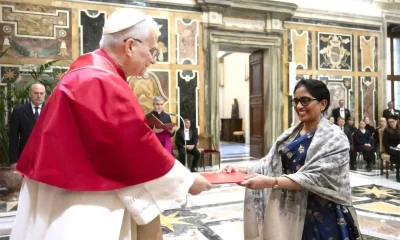
 News5 days ago
News5 days agoPope fires broadside: ‘The Holy See won’t be a silent bystander to the grave disparities, injustices, and fundamental human rights violations’
-

 News5 days ago
News5 days agoPakistan hands over 200 tonnes of humanitarian aid to Lanka
-
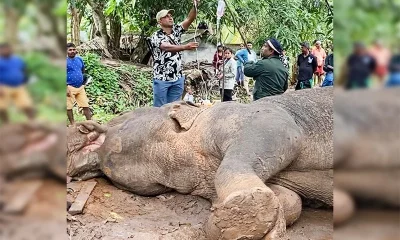
 News6 days ago
News6 days agoBurnt elephant dies after delayed rescue; activists demand arrests
-

 Business4 days ago
Business4 days agoUnlocking Sri Lanka’s hidden wealth: A $2 billion mineral opportunity awaits
-
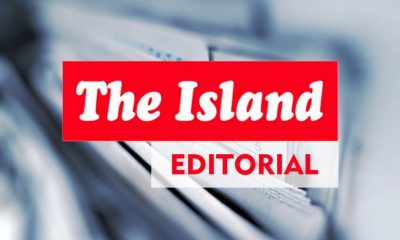
 Editorial6 days ago
Editorial6 days agoColombo Port facing strategic neglect
-

 News4 days ago
News4 days agoArmy engineers set up new Nayaru emergency bridge
-

 News6 days ago
News6 days agoSri Lanka, Romania discuss illegal recruitment, etc.


